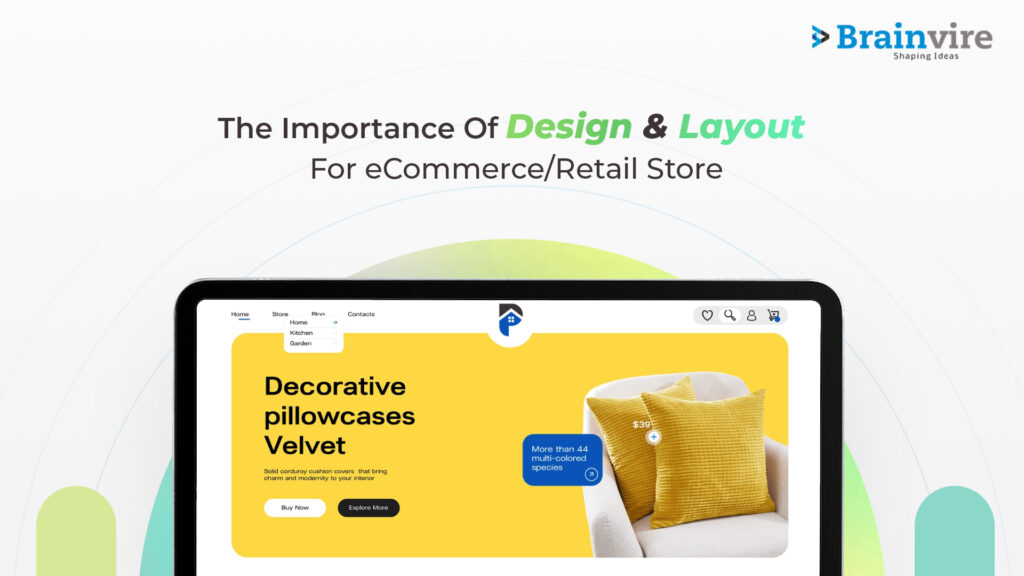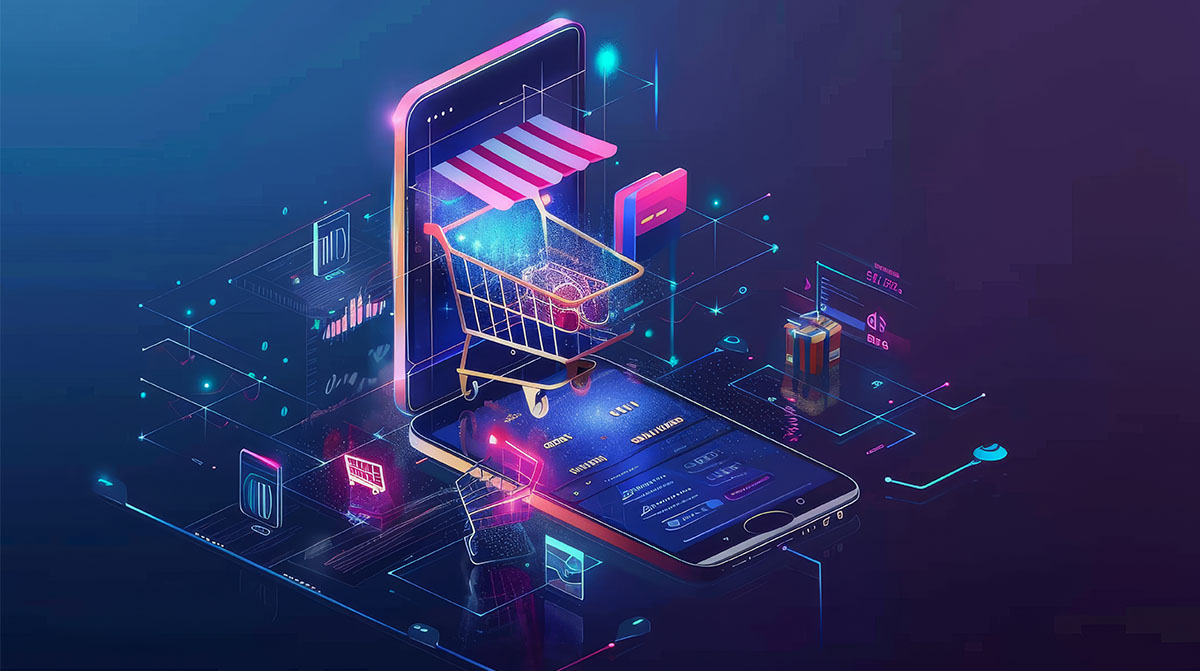Importance Of Store Layout In eCommerce Stores
1. First Impression Matters
Whether it’s an outlet or an online store, you’ll swear by ‘first impression is the last impression’ when you enter retail. A customer’s first impression of a store can determine whether or not they enter, stay for a look around, and make a purchase.
However, most owners don’t get the concept entirely. Today, store owners beautify their retail outlets or website to make them more appealing. But, sadly, the look’s not enough for conversion.
To ensure that your retail establishment makes an excellent first impression on customers, keep the following in mind:
1.1. The Store’s Exterior and Entrance Are the First Things Customers See:
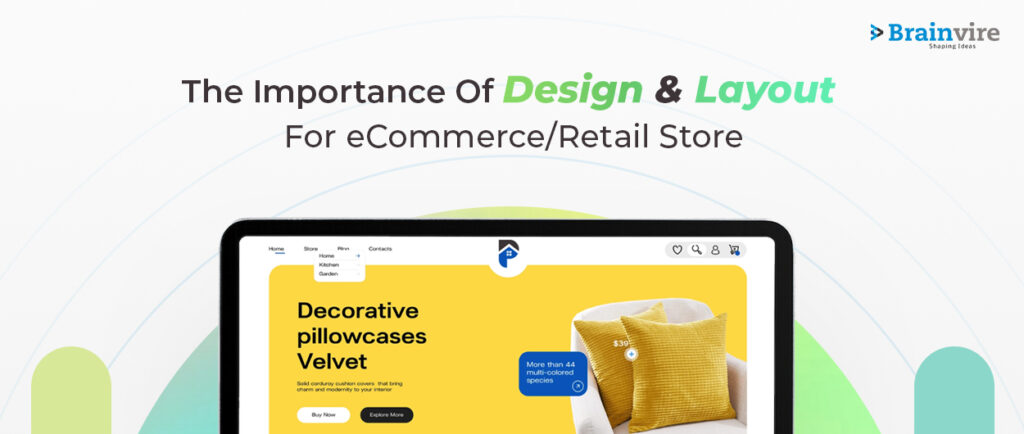
The importance of ecommerce web development cannot be overstated, particularly when considering the impact it has on creating a favorable first impression for potential customers. Just as a physical store’s exterior serves as the initial point of contact, it is crucial for it to be immaculate, well-maintained, and visually appealing. Moreover, legible signage that is prominently displayed plays a key role in ensuring ease of visibility.
By implementing these elements, businesses can leave a lasting positive impression on customers, ultimately encouraging them to explore further. Interestingly, the same principle applies to ecommerce stores. It becomes essential to recognize that a dull or unpleasant landing page design can hinder the ability to attract and engage customers effectively.
1.2. a Well-Designed Storefront Can Attract Attention and Entice Customers to Enter:
Whether online or offline, you can’t attract customers with a dull or average theme. Your store’s entrance needs to be as appealing as it can be. So draw in customers with bright colors, interesting lighting, and eye-catching displays.
An eye-catching storefront can pique a customer’s interest and curiosity about what’s within. However, when incorporating the same things over an eCommerce store, ensure that you have a well-designed homepage and a unique logo that entices customers to enter.
1.3. the Store’s Layout and Design Should Create a Positive and Inviting First Impression:
Customers should feel at ease and welcome when they enter your outlet or website. Therefore, the store’s design should be logical and straightforward, with apparent points of sale and merchandising.
Keep the area clean and uncluttered so people can move about without hassle. The same goes for eCommerce stores. So try to keep it clear. But at the same time, design it to engage customers to explore your products.
Next, we have the navigation and flow of your store. As an owner, you should always design store layouts that prioritize ease of use and customer movement. A well-planned store layout facilitates consumer navigation and encourages them to peruse the many sections and products.
While planning the layout of your retail/eCommerce space, keep the following in mind:
2.1. the Layout Should Be Intuitive and Easy to Navigate
The shopping experience should be streamlined and speedy for the customer. The store’s layout should make sense, with prominent signs and well-organized exhibits.
Aisles and walkways need to be broad enough for customers to stroll down easily, and there needs to be enough room between exhibits so shoppers don’t bump into one another. Finally, keep things neat and in good working order. Similarly, you could replace aisles and walkways with tables and categories in your eCommerce store.
2.2. Customers Should Be Able to Find What They’re Looking for Quickly and Easily.
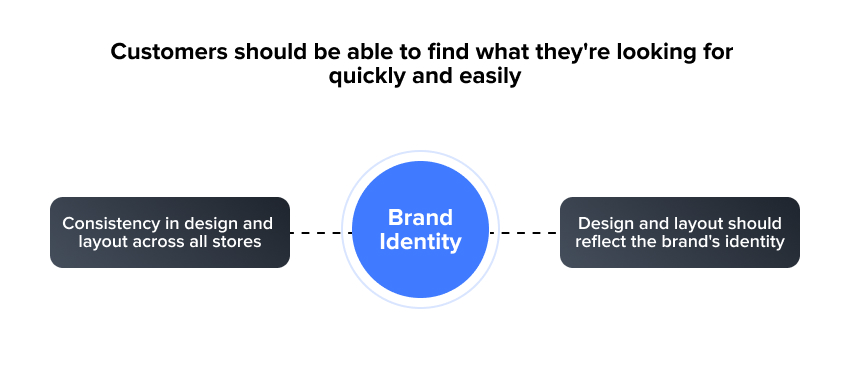
Help shoppers find what they’re looking for quickly and easily. Put items of a similar nature together and make the labels and signs easily legible. Customers can find the sections of the store that interest them more quickly if you use color coding and distinct signage for each type of product.
At larger establishments, it may be worthwhile to install interactive displays or touch screens to aid shoppers in their search for specific items. However, if you plan to design an intuitive eCommerce website, limiting your store to a few pages would be wise.
Having hundreds of pages in your eCommerce store could only lead to confusion and difficulty in operations.
2.3. the Flow Of The Store Should Lead Customers To Explore Different Areas And Products.
Create a flow throughout the store that invites people to browse around. Lead consumers through the store by placing high-demand or high-profit items near the entrance.
Ensure best-sellers are front and center and use eye-catching displays to draw attention to sales and new offerings. Customers can be directed to specific store sections by using color and lighting. The same can be said for your online store where you could use different themes to define different store sections.
3. Brand Identity And Consistency
Maintaining the brand’s visual identity and tone throughout the store is crucial. Therefore, it is important for a store’s design to not only be aesthetically pleasing but also to be reflective of the brand’s identity and values.
Maintaining visual cohesion across brick-and-mortar locations and online marketplaces helps build consumer confidence in your brand. Some important things to keep in mind regarding storewide brand identity and uniformity are as follows:
3.1. The Store’s Design And Layout Should Reflect The Brand’s Identity And Values
Your retail space’s aesthetics must reflect your company’s beliefs and principles. The design and feel of your store should be consistent with the brand’s identity, values, and goals.
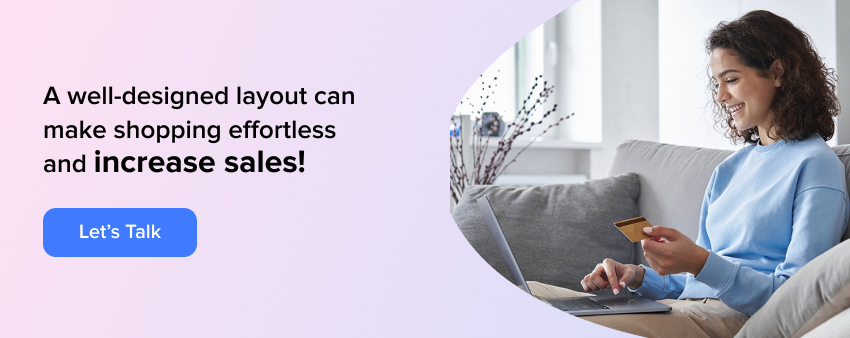
Everything from the wall paint to the lighting to the signs advertising your wares is part of this. On the contrary, when planning to develop your online store, you should design your page, considering your company’s ideals and implementing them into the store’s aesthetic and layout.
3.2. Consistency In Design And Layout Across All Stores And Ecommerce Platforms Reinforces Brand Recognition And Trust.
Maintaining visual cohesion across brick-and-mortar and digital channels is crucial for building customer confidence in your brand. This implies that all your establishments, no matter where they are located, should share a consistent aesthetic.
Your online store’s style and aesthetic should be in keeping with the rest of your brand’s materials. Customers will be more likely to remember your company and return for future purchases if you maintain a consistent brand identity across all touchpoints.
4. Highlighting Products And Promotion
It is crucial in the retail industry to display products and sales in the most eye-catching manner. These items and sales must be prominently displayed throughout your business. Thus careful consideration must be given to the store’s design and layout.
More people will buy more of your company’s products and take advantage of your services if you use eye-catching displays and signage.
4.1. the Store’s Design and Layout Should Highlight Products and Promotions Effectively.
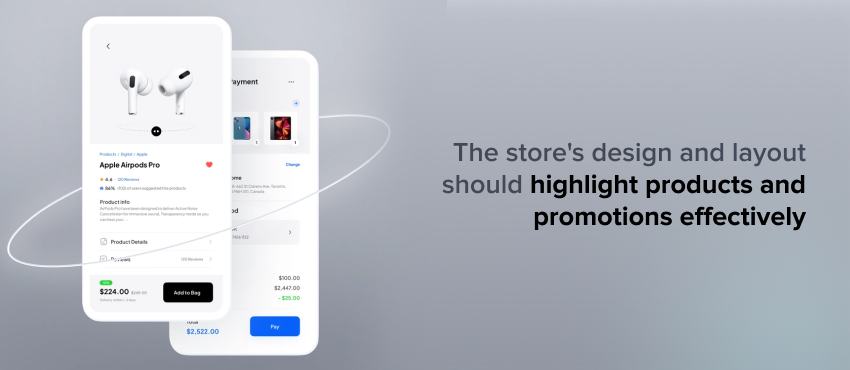
Storefront aesthetics have been shown to impact customers’ propensity to make purchases significantly. Putting the spotlight on sales and special offers is one strategy.
The first step is to develop a store layout appealing to customers and easy to navigate so they feel compelled to check out everything you offer. This can be accomplished by arranging the store’s layout so customers can easily navigate through, sorting products into distinct sections, and leaving plenty of breathing room between the various displays.
Making products and deals easily accessible to clients is another crucial step in drawing attention to them. Using mannequins or themed displays to highlight certain items is a great method to grab customers’ attention.
Color, lighting, and signage are other tools retailers can use to draw attention to products and promotions create a sense of urgency or excitement. Interestingly, these factors can be used for both offline and online stores.
4.2. Attention-Grabbing Displays And Signage Can Attract Customers To Specific Products And Promotions.
Using eye-catching displays and signs helps attract shoppers’ focus on particular goods and offers. They should be positioned prominently in the shop at the entrance or a heavily traveled section. In addition, stores can attract customers’ attention to new products or promotions through eye-catching displays, including window displays, end caps, and feature walls.
Product and sale visibility can also be increased through the use of signage. Signs are a great way for stores to promote deals, discounts, or new items. A sign can also draw attention to a sale or advertise a new product.
The best signs are those that get their point through quickly and can be read from a distance. Signs can have a greater impact if they are creatively designed, which is something retailers can do. However, when making these changes in an online store, you might want to use the psychology of colors to attract potential clients.
5. Creating Memorable Experiences
Customers’ willingness to recommend your business to others directly results from the positive impression you left on them. Therefore, creating a one-of-a-kind and individualized customer experience is crucial in today’s retail industry.
If you want to give your customers an experience they won’t forget, keep these two things in mind:
5.1. a Unique And Memorable Store Design Can Create a Positive And Lasting Impression
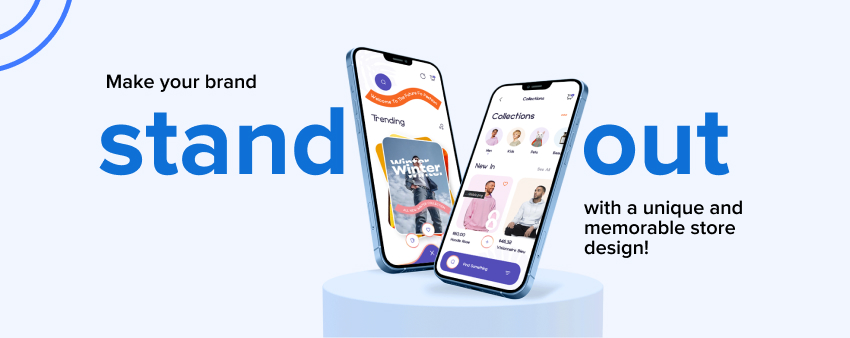
How a business is laid out can affect how customers feel about the brand. Your brand can stand out from the crowd with the help of a beautifully designed store. Your brand’s identity and values should inform a unique retail space design.
Whether a retail outlet or an online store, the space must be aesthetically pleasing and welcoming to put clients at ease. Customers can be left with a lasting impression through elements like ambiance, sound, and smell.
5.2. A Personalized And Engaging Customer Experience Can Increase Brand Loyalty And Encourage Repeat Business.
Brand loyalty and customer retention can be improved by providing a unique and interesting experience. This can be accomplished in several ways, including but not limited to delivering individualized suggestions, excelling at customer service, and fostering a sense of belonging.
Your store could achieve a tailored experience by encouraging customer participation via social media and other digital channels. Businesses can strengthen their relationships with customers over the long term by actively listening to and responding to customer feedback. The objective is to satisfy the patrons, so they can’t wait to return for more.
6. Maximizing Sales
One of the most crucial objectives of every company is to maximize sales, and there are numerous strategies for doing so. Businesses can boost sales and income by taking numerous actions, such as optimizing store layout and strategically positioning products and promotions.
Some essential considerations for increasing sales are as follows:
6.1. A Well-Designed Store Layout Can Maximize Sales And Revenue
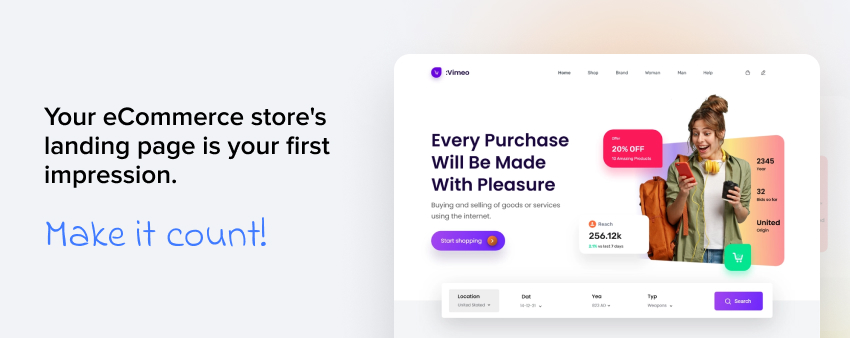
The success of a business greatly depends on the store’s layout. Thanks to a well-thought-out layout, customers should find it effortless to browse the store and locate their desired items. Customers should have a consistent experience with the brand, which may be achieved by the layout’s adherence to the business’s identity and values.
Customers are more likely to stay in a store if they enjoy what they see, hear, and smell. Therefore, it’s important to consider how these factors can affect your business. On the contrary, if you plan to implement such elements in your eCommerce store, you could work on its UI.
6.2. Effective Placement Of Products And Promotions Can Increase Impulse Purchases And Average Order Value.
Product and marketing placement can have a substantial effect on retail sales. Putting high-profit or best-seller items upfront helps boost sales from impulse buys. Customers are more likely to make extra purchases when related products are shown together.
Thanks to cleverly positioned promos and discounts, customers can be enticed to try new things or make greater purchases. In addition, businesses can increase their sales and profits by constantly evaluating sales data and consumer behavior to find the best locations for products and promotions.
7. eCommerce Store Design
To be successful in today’s digital world, businesses need an attractive online storefront. Customers are more likely to return to a store that is aesthetically pleasing and simple to browse than one that is neither. Therefore, when planning the layout of your online store, keep these two things in mind:
7.1. A Well-Designed Ecommerce Store Should Be Visually Appealing and Easy To Navigate
An online shop’s layout should look nice and be simple to use. In addition, the site’s layout should be user-friendly so customers can quickly find what they need and purchase.
The home page should be neatly laid out and visually appealing, with prominent CTAs that inspire consumers to continue exploring the site. In addition, more and more people are making purchases from their mobile devices; thus, the site must be optimized for them.
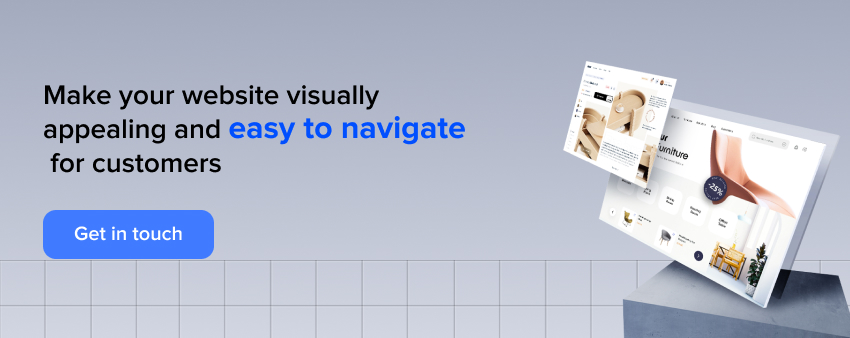
The website’s aesthetic should reflect the core beliefs and principles of the company. The brand’s identity can be conveyed by selecting appropriate colors, fonts, and images. In addition, the aesthetic attractiveness of the site can be improved by including high-quality photographs and videos of the products.
One more important part of an online shop’s layout is navigation. The site’s navigation should make sense and be simple, with a clean structure for its many sections. Customers should easily search for goods using a displayed search bar. The checkout procedure should be uncomplicated and quick to reduce shopping cart abandonment.
7.2. Consistency In Design And Layout Across All Website Pages Can Improve The User Experience.
Maintaining a uniform style and layout throughout the website is essential for success. Consumers should be able to quickly move through the site and obtain the information they need, no matter what page they are on. Every page should follow the same format, with a consistent header and footer, and use the same typeface, color palette, and images.
Similarly, the optimization of the site’s layout for speed and functionality is crucial. It is important to web-optimize images to reduce page load times and improve the overall speed of page loading. Customers may become frustrated and abandon their shopping carts if the website takes too long to load.
The website’s content should also be consistent and up-to-date, in addition to visual consistency. The inclusion of details such as product descriptions, prices, and availability is essential. Misleading or out-of-date details can prevent customers from losing faith, affecting ratings and recommendations.
8. Mobile Optimization
E-commerce sites must prioritize mobile optimization as the number of clients who shop from their mobile devices grows. Therefore, companies must ensure their online store is mobile-friendly so customers can shop easily. Some essential considerations for mobile optimization are as follows:
8.1. With The Rise In The Usage Of Mobile Devices For Online Shopping
it has become imperative for eCommerce stores to proactively optimize their platforms for mobile. Additionally, by catering to mobile users, businesses can effectively tap into a wider customer base and enhance their overall user experience.
The increasing popularity of mobile internet shopping has made mobile optimization a must for eCommerce businesses. As a result, over half of all eCommerce sales will occur on mobile devices by 2024.
A poor user experience caused by a lack of mobile optimization may result in fewer purchases and dissatisfied customers. In addition, mobile-friendly sites tend to perform better in search engine results; thus, optimizing for mobile can boost SEO.
8.2. Responsive Design And Simplified Navigation Can Improve The Mobile Shopping Experience.
Having a mobile-friendly, responsive layout is crucial for search engine rankings. A responsive layout enables effective viewing of a website on any device, regardless of the user’s screen size. This means that the website’s layout will change depending on the size of the viewer’s screen, making it suitable for use on mobile devices.
A streamlined navigation layout can enhance the convenience of mobile shopping. This means the menu items should be visible, and the checkout procedure should take at most two or three clicks. Additionally, clear and concise calls to action can prompt customers to perform the desired action more quickly on a mobile device.
9. Customer Feedback & Analytics
In the pursuit of enhancing the customer experience, businesses are placing growing importance on gathering and analyzing customer feedback and analytics. Furthermore, these insights serve as valuable information that enables companies to make informed decisions and optimize their strategies.
For example, retailers can gather valuable insights about their customers’ habits, likes, and dislikes, and then utilize this information to improve store layout, product placement, and advertising.
9.1. Regularly Gathering Customer Feedback And Analyzing Analytics Can Help Optimize Store Design And Layout.
Their comments can gauge how customers feel about a store’s design and layout. Retailers can learn more about what works and doesn’t in-store design by soliciting customer input. For example, customers may complain about the store’s layout, pointing out that some sections need to be more light and clear to navigate easily.
Retailers can learn more about consumers’ habits through direct feedback and analytics data. For example, retailers can benefit from data analysis of customer traffic patterns and sales performance by determining which parts of the store could benefit from reorganization or improvement.
For instance, if sales figures reveal that a product line is underperforming, a business may showcase it more prominently. Or, you could pair the product with your top-selling product to promote sales.
9.2. Understanding Customer Behavior And Preferences Can Inform Product Placement, Promotional Strategies, And Overall Store Design.
Retailers can learn more about what products connect with customers and what promotional techniques work best by monitoring customer behavior and preferences. For example, retailers may strategically stock higher-margin items in high-traffic areas of the shop based on statistics showing that customers spend more time there.
Customers’ preferences also influence the store’s layout. By collecting client feedback on preferred lighting and color schemes, stores may make their establishments more comfortable and welcoming. As a result, retailers may encourage repeat business by providing a pleasant shopping environment where customers like spending time.
10. Evolving With Trends And Changes
Understanding the dynamic nature of the retail and eCommerce industry is the initial step towards adaptation. Transitioning from that, changes in consumer preferences, buying behaviors, and technological advancements can significantly impact customer engagement with retailers and eCommerce platforms. Consequently, businesses must remain attuned to these transformations and exhibit flexibility in order to thrive in the current market.
Understanding the dynamic nature of the retail and eCommerce industry is the initial step towards adaptation. Transitioning from that, changes in consumer preferences, buying behaviors, and technological advancements can significantly impact customer engagement with retailers and eCommerce platforms. Consequently, businesses must remain attuned to these transformations and exhibit flexibility in order to thrive in the current market.
Keeping up with the latest developments and trends in your field might help. A few ways to do this include participating in trade shows, reading relevant periodicals, and keeping tabs on industry thought leaders. In addition, businesses may better prepare for shifts and adapt to new circumstances if they keep up with industry news and trends.
To stay current and competitive, it is imperative to maintain agility and adaptiveness. This entails exploring various approaches and promptly making adjustments when needed. By being nimble and quick to act, companies can effectively respond to market shifts and gain an edge over their competitors.
10.2. Regularly Evaluating And Updating Store Design And Layout Can Keep The Business Relevant And Competitive.
Maintaining an up-to-date store design and layout is another crucial part of keeping up with the times. Product placement, store design, and decor can affect a customer’s shopping experience and purchases.
Retailers should periodically assess the design and layout of their stores and make any required adjustments to keep the business successful and competitive. For example, changing the store’s atmosphere could mean installing new lighting, moving shelves around, or adding interactive displays.
Stores can better meet the demands of modern consumers by constantly assessing client feedback and adjusting the store’s layout and fixtures.
Conclusion
A well-designed and laid-out retail or online store is essential to attracting and retaining customers, driving revenue growth, and building name recognition. In addition to increasing sales and profits, a well-designed storefront or website will keep customers returning.
Successful retail and eCommerce operations generate value and consumer satisfaction by prioritizing various aspects. Firstly, they emphasize creating positive first impressions. Transitioning from that, they pay attention to effective navigation and flow within their platforms. Moreover, they excel at showcasing products and promotions to capture customer interest. Additionally, they strive to provide a memorable experience for shoppers. Lastly, they remain up to date with the latest trends and developments in the industry.
In order to remain competitive and achieve continued success in the present market, companies need to regularly evaluate and improve their store design and layout. Additionally, they should actively seek customer feedback and promptly adapt to changing market conditions.
Continue reading: Brainvire Assists A Prominent Knife ECommerce Website With Shopify For Excellent User Experience
FAQs
A store’s design affects sales if it attracts and captivates customers, encouraging them to browse and make a purchase. The strategic positioning of products and advertisements can help boost spontaneous purchases and average order value.
To strengthen the company’s identity, the store’s layout and decor should reflect the principles and personality of the brand. Having the same look and feel across brick-and-mortar locations and online channels helps build consumer confidence in your brand.
A store’s design can significantly impact customers’ feelings about their shopping experience. Factors like ease of use, visibility of products, and attractiveness of displays can affect customer satisfaction.
For an optimal mobile purchasing experience, an eCommerce store’s design should prioritize a visually appealing and intuitive layout, page-to-page consistency in design and layout, and mobile optimization.
Businesses should regularly evaluate and update store designs and layouts to ensure continued relevance. Collecting customer input and analyzing statistics can help guide product placement, marketing, and layout decisions.
The rising use of mobile devices makes mobile optimization crucial for online shops. A responsive layout and user-friendly navigation enhance the mobile shopping experience, increasing consumer satisfaction and driving more purchases.
Related Articles
-
Creating an Effective High-Value Content Supply Chain to Maximize Impact and Engagement
Maintaining the demand for personalized customer experiences requires a robust and scalable content supply chain (CSC). Organizations struggle to maintain efficiency across planning, creation, delivery, and measurement. Investing in an
-
5 Reasons to Choose nopCommerce For Your Next eCommerce Development Project
Talking About 5 Reasons to Choose nopCommerce For Your Next eCommerce Development Project, In a world where netizens are growing with time, eCommerce has become a business need. To cater
-
Transforming DevOps Trends to Follow in 2021
DevOps is a leading intuitive technology and has gained tremendous recognition recently. No wonder an increased number of businesses have adopted this technology and make wise use of it. USD

